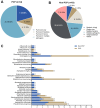Risk factors for identifying pneumocystis pneumonia in pediatric patients
- PMID: 39507946
- PMCID: PMC11537976
- DOI: 10.3389/fcimb.2024.1398152
Risk factors for identifying pneumocystis pneumonia in pediatric patients
Abstract
Objectives: This study aimed to identify the risk factors and construct the diagnostic model associated with pneumocystis pneumonia (PCP) in pediatric patients.
Methods: This retrospective observational study analyzed 34 cases of PCP and 51 cases of other types of pneumonia treated at Children's Hospital Affiliated to Shandong University between January 2021 and August 2023. Multivariate binary logistic regression was used to identify the risk factors associated with PCP. Receiver operating characteristic curves and calibration plots were constructed to evaluate the diagnostic model.
Results: Twenty clinical variables significantly differed between the PCP and non-PCP groups. Multivariate binary logistic regression analysis revealed that dyspnea, body temperature>36.5°C, and age<1.46 years old were risk factors for PCP. The area under the curve of the diagnostic model was 0.958, the P-value of Hosmer-Lemeshow calibration test was 0.346, the R2 of the calibration plot for the actual and predicted probability of PCP was 0.9555 (P<0.001), and the mean Brier score was 0.069. In addition, metagenomic next-generation sequencing revealed 79.41% (27/34) and 52.93% (28/53) mixed infections in the PCP and non-PCP groups, respectively. There was significantly more co-infection with cytomegalovirus and Streptococcus pneumoniae in the PCP group than that in the non-PCP group (p<0.05).
Conclusions: Dyspnea, body temperature>36.5°C, and age<1.46 years old were found to be independent risk factors for PCP in pediatric patients. The probability of co-infection with cytomegalovirus and S. pneumoniae in the PCP group was significantly higher than that in the non-PCP group.
Keywords: area under the curve; metagenomic next-generation sequencing; pediatric; pneumocystis pneumonia; receiver operating characteristic curve.
Copyright © 2024 Zhang, Li, Chen, Wang, Yang, Xu and Wang.
Conflict of interest statement
The authors declare that the research was conducted in the absence of any commercial or financial relationships that could be construed as a potential conflict of interest.
Figures




Similar articles
-
Risk factors for identifying pulmonary aspergillosis in pediatric patients.Front Cell Infect Microbiol. 2025 Jun 27;15:1616773. doi: 10.3389/fcimb.2025.1616773. eCollection 2025. Front Cell Infect Microbiol. 2025. PMID: 40654574 Free PMC article.
-
Development of a clinical risk score for the prediction of Pneumocystis jirovecii pneumonia in hospitalised patients.BMC Infect Dis. 2024 Sep 27;24(1):1032. doi: 10.1186/s12879-024-09957-y. BMC Infect Dis. 2024. PMID: 39333914 Free PMC article.
-
The association between Cytomegalovirus co-infection with Pneumocystis pneumonia and mortality in immunocompromised non-HIV patients.Clin Respir J. 2018 Nov;12(11):2590-2597. doi: 10.1111/crj.12961. Clin Respir J. 2018. PMID: 30244544
-
Risk Factors of Mortality From Pneumocystis Pneumonia in Non-HIV Patients: A Meta-Analysis.Front Public Health. 2021 Jun 16;9:680108. doi: 10.3389/fpubh.2021.680108. eCollection 2021. Front Public Health. 2021. PMID: 34222179 Free PMC article.
-
[Pneumocystis pneumonia in HIV-infected patients with cytomegalovirus co-infection. Two case reports and a literature review].Pneumonol Alergol Pol. 2014;82(5):458-66. doi: 10.5603/PiAP.2014.0060. Pneumonol Alergol Pol. 2014. PMID: 25133815 Review. Polish.
Cited by
-
Risk factors for identifying pulmonary aspergillosis in pediatric patients.Front Cell Infect Microbiol. 2025 Jun 27;15:1616773. doi: 10.3389/fcimb.2025.1616773. eCollection 2025. Front Cell Infect Microbiol. 2025. PMID: 40654574 Free PMC article.
References
-
- Chang C., Wang H., Zhang L., Hao J., Wang X., Wang Y., et al. . (2023). Clinical efficiency of metagenomic next-generation sequencing in sputum for pathogen detection of patients with pneumonia according to disease severity and host immune status. Infect. Drug Resist. 16, 5869–5885. doi: 10.2147/IDR.S419892 - DOI - PMC - PubMed
-
- Donnelly J. P., Chen S. C., Kauffman C. A., Steinbach W. J., Baddley J. W., Verweij P. E., et al. . (2020). Revision and update of the consensus definitions of invasive fungal disease from the European organization for research and treatment of cancer and the mycoses study group education and research consortium. Clin. Infect. Dis. 71, 1367–1376. doi: 10.1093/cid/ciz1008 - DOI - PMC - PubMed
Publication types
MeSH terms
LinkOut - more resources
Full Text Sources

